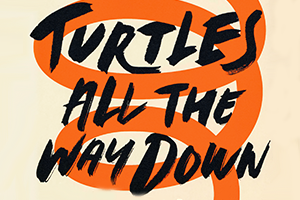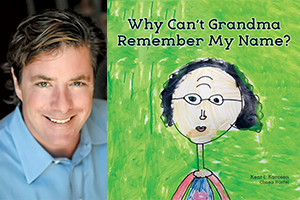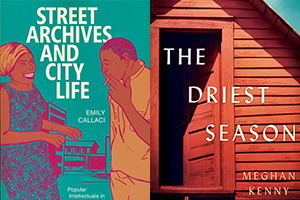The Cheerful Critic
How Margaret Willison '07 turned her love of pop culture into a mini media empire.
Read The StoryIn his latest best-selling novel, “Turtles All the Way Down,” John Green ’00 H’16 plumbs the depths of his own struggles with obsessive-compulsive disorder and creates one of his most memorable characters to date — an amateur teen detective named Aza Holmes, who shares his diagnosis.
This essay by Green was originally published in the October 2017 issue of the Costco Connection magazine and is reprinted here with the permission of the Costco Connection.
It's been almost six years since the publication of my previous novel, “The Fault in Our Stars.” A lot happened during that time: My daughter was born; my brother and I started our educational video channel “Crash Course;” a couple movie adaptations of my books were filmed and released. But a true accounting of these six years would include this uncomfortable fact: A lot of that time was completely lost to an incapacitating terror.
There is an old and pervasive lie that to be creative, you must also be mentally ill. If you type, “All artists are” into Google, Google autofills “mad.” It’s true that artists live with mental illness, but so do food service workers. And dentists.
Our culture strongly stigmatizes mental illness — the sick are too often seen as unreliable, dangerous and without value — but we also romanticize it. From Sherlock Holmes to Carrie Mathison in “Homeland,” brilliant detectives are often portrayed as brilliant because of their madness. That may be true to some people’s experiences, but it isn’t true to mine. My obsessive-compulsive disorder comes with no superpowers. It has not turned me into a brilliant detective. In fact, when I am sick, I am a terrible detective, because I find it completely impossible to apprehend anything outside of the consuming terror of myself.
My new book, “Turtles All the Way Down,” is my attempt to write a story about a detective whose brain disorder is distinctly unhelpful. It’s entirely fictional, but it is also for me a very personal fiction, because Aza’s thought spirals borrow a lot from mine, and because most of this book was written after an extended period of unwellness.
In the story, 16-year-old Aza is trying to understand the world around her, but she cannot escape the prison of her own thoughts. Her brain forces her to think, nearly constantly, thoughts she does not wish to have. She knows her fears are mostly irrational, but she can’t stop having them. And she wonders: If you can’t choose your thoughts, but your thoughts are central to what make you yourself, then who precisely is driving the bus of your consciousness? It’s terrifying to feel that you are stuck inside a body you can’t control. It’s like being locked inside a prison that is precisely the size of yourself.
It’s like living inside an ever-tightening spiral. But saying it’s like this or like that is part of the problem: Aza struggles to find direct form or expression for her pain, because it evades the senses. I think that’s part of what makes psychic pain — and really any chronic pain — so horribly isolating. You can say what it’s like, but you can’t say what it is. I wrote “Turtles All the Way Down” in the hopes of finding form for that way-down terror that has accompanied me for so much of my life, and in the hopes that Aza’s story might help me and others feel unalone.

Web extra: In the summer 2016 issue of the Alumni Bulletin, John Green shares insight into his writing process.
It’s well-known that John Green ’00 H’16 is a star in the young adult fiction world. But how do Kenyon students feel about him? Alumni Bulletin intern and John Green aficionado Carolyn Ten Eyck ’18 asked several students about their connection to Green’s latest book, “Turtles All the Way Down,” and here’s what they had to say:
"People like to make fun of young adult fiction like it’s something trivial and unworthy of critical regard, and I think they forget how big of a deal it is when you’re in high school (or really when you’re any age) to find, for the first time, a story you really see yourself in. In its handling of mental illness, I think “Turtles All the Way Down” is going to be that book for a lot of people. What really struck me, though, and what distinguished this book from others like it, is the nuanced, realistic and sympathetic way it deals with the effect that having a mental illness has on the people around you." — Emma McGorray '18
"The book is just beautiful. I honestly believe that it’s his strongest writing, and Aza is my favorite protagonist that he’s written. She’s smart and has such a good character arc, and Green presents her with such nuance. It was a privilege to be allowed into her world, and, in many ways, it felt like the book gave me language to better understand the real world. That’s one of the best things about books like this: In all connecting with characters like Aza, we end up connecting to one another. We can talk about big and complex issues through the lens of incredible books like this, and it allows us to grow closer to the people around us." — Emily Daluga '17
"What I found most interesting about the book was Green’s display of the main character’s anxiety. She (has an extreme fear of germs), so much that she is constantly thinking about the bacteria in her own body being unsettling. Green does a great job of portraying what is going on in her mind when her almost debilitating anxiety sets in. For someone who does have anxiety, I believe this book may serve as a sign of hope that no matter what they have been through, it can and will get better, and life will go on." — Morgan Engmann ’20
Web extra: Yasmin Nesbat '18 takes to the streets of Gambier to uncover the secret meaning behind the phrase "Turtles All the Way Down."
How Margaret Willison '07 turned her love of pop culture into a mini media empire.
Read The StoryKenyon alumni from different disciplines explain how long-term stress takes a toll on our health — and how we…
Read The StoryFrom doughnuts to e-cigarettes, Kenyon students use science to educate middle schoolers on addiction.
Read The Story










